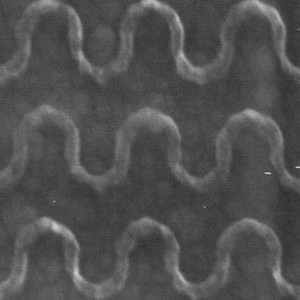January 10, 2007 feature
A New Reflection in the Mirror

A research group has devised a new type of mirror that reverses the magnetic field of a light wave upon reflection, rather than its electric field, as regular mirrors do. Seems like a minor difference? It's not.
“Our mirror's ability to reverse the magnetic field of a light wave but not its electric field is extremely unusual,” physicist Alexander Schwanecke, the study's corresponding scientist, said to PhysOrg.com. Schwanecke is a researcher at the NanoPhotonics Portfolio Centre at the University of Southampton in the United Kingdom. “It is the first demonstration of an entirely new type of optical tool.”
A typical household mirror works like this: Photons (particles of light) bounce off an object or person, hit the mirror, and are absorbed by electrons on the surface of its metal backing. The electrons almost instantly emit “reflected” photons (not the same photons that came in, as those are absorbed and gone), which travel to our eyes, allowing us to see our image. Photons that strike the mirror head-on are reflected squarely back, and those hitting at an angle are reflected at the same angle in the other direction, forming a V-shaped path. This is the law of reflection.
To understand the work by Schwanecke and his colleagues, however, we must remember that light is both a particle and a wave, and that, as a wave, it consists of an electric-field component and a magnetic-field component. After a reflection, the direction of the emitted light wave's electric field is reversed (this is one type of a “phase change”) but the magnetic component is not.
This magnetic mirror produces the opposite scenario: a flipped magnetic field and an unchanged electric field. The mirror has three layers: a layer of aluminum, a layer of silicon dioxide, and finally a layer of carefully arranged aluminum nanowires, shaped into a wavy pattern that the researchers call “fish scales.” The fish-scale shape is important because it allows the light to interact with the nanowires in a particular way, due to the spacing between each “scale.” As a result, the scales resonate with the light much like molecules would.
The mirror is tiny and square, about 500 micrometers (millionths of a meter) on each side, and contains about one million fish-scale-shaped elements. It works best for visible light, but the group expects that, with some tweaks to the fish-scale pattern, near-infrared light would work, too.
The nanowire layer is the key to the mirror's function. The curved nanowire “fish scales,” like molecules, have dimensions that are smaller than the wavelength of visible light. This means that they can interact with the light to influence or directly produce the material's overall optical response, in this case, a reversal of the light's magnetic field.
The researchers discovered the mirror's ability by observing a reflection using an interferometer, a device that can detect the difference in behavior of two light waves by recording what happens when they “interfere,” or cross paths.
“One characteristic of our mirror is that it is very sensitive to energy losses at the surface,” said Schwanecke. “This property could make it very useful for improving devices that work by detecting light, such as photodetectors.”
The mirror could also be useful, he says, in the detection of tiny particles or molecules near the mirror’s surface. If a particle or molecule was nearby and emitted a photon, the mirror would reflect the photon’s electric component without reversing it. A “normal” mirror would reverse it, thus weakening the signal and making it harder to detect the photon and, by extension, the particle or molecule.
The mirror’s potential to work with near-infrared light (light close to the visible range but still in the infrared) could make it advantageous to the telecommunications industry, in which near-infrared light is commonly used.
Citation: A.S. Schwanecke, V.A. Fedotov, V.V. Khardikov, S.I. Prosvirnin, Y. Chen, and N.I. Zheludev, “Optical magnetic mirrors.” J. Opt. A: Pure Appl. Opt. 9 (2007) L1-L2
By Laura Mgrdichian, Copyright 2006 PhysOrg.com.
All rights reserved. This material may not be published, broadcast, rewritten or redistributed in whole or part without the express written permission of PhysOrg.com.





















